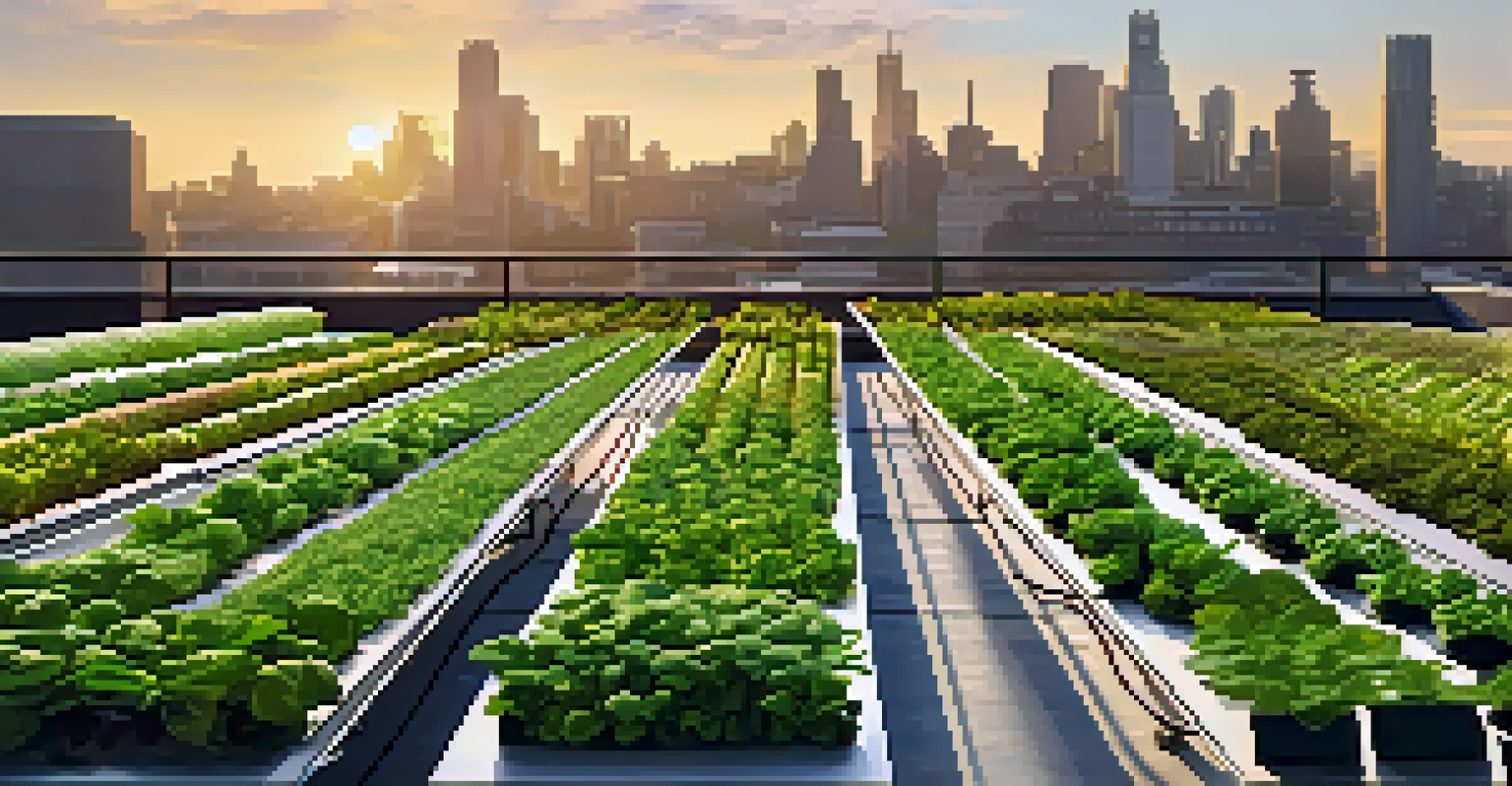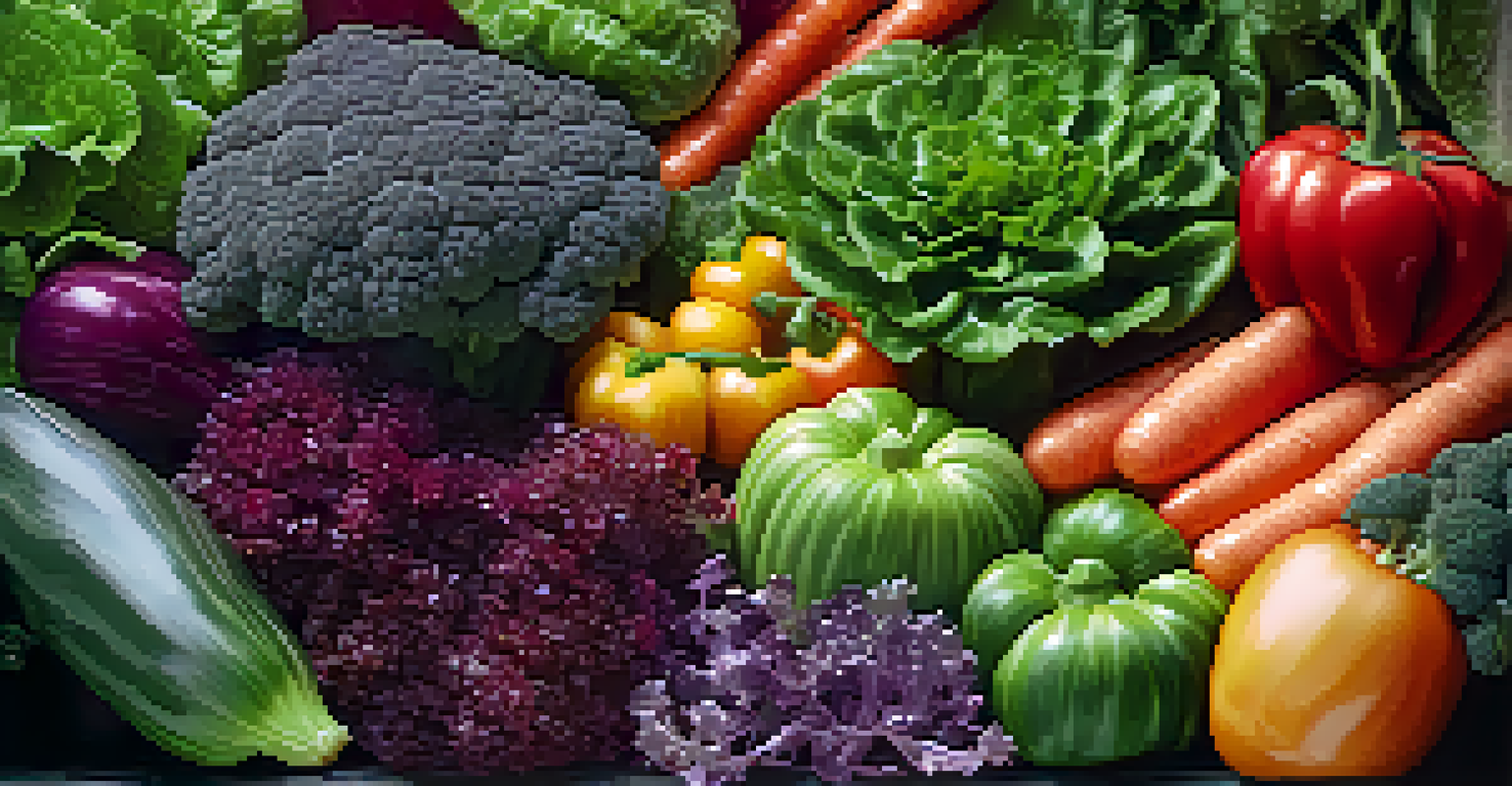Vertical Farming: Maximizing Space for Sustainable Food Production

Understanding Vertical Farming and Its Benefits
Vertical farming is a revolutionary approach to agriculture that involves growing crops in stacked layers or vertically inclined surfaces. This method allows for the efficient use of space, especially in urban areas where land is limited. By utilizing controlled environments, vertical farms can produce food year-round, independent of seasonal changes.
The future of food is vertical farming, where we can grow fresh produce right where it’s consumed, reducing transportation costs and carbon footprints.
One of the primary benefits of vertical farming is its potential to reduce the carbon footprint associated with traditional agriculture. By growing food closer to urban centers, transportation distances are minimized, leading to less fuel consumption and lower greenhouse gas emissions. Additionally, the controlled environments of vertical farms can significantly reduce the need for pesticides and herbicides.
Moreover, vertical farming can contribute to food security in rapidly urbanizing areas. With the global population projected to reach 9 billion by 2050, finding sustainable ways to feed everyone is crucial. Vertical farms can be set up in various locations, including rooftops and warehouses, making fresh produce accessible to city dwellers.
How Vertical Farming Works: The Technology Behind It
Vertical farming relies on advanced technologies to create the optimal conditions for plant growth. Hydroponics, aeroponics, and aquaponics are some of the methods used in this innovative farming practice. Hydroponics, for instance, involves growing plants in nutrient-rich water, eliminating the need for soil and allowing for faster growth rates.

LED lighting is another critical component of vertical farms, providing the necessary light spectrum for photosynthesis while using less energy. These lights can be programmed to optimize growth cycles, which means plants can grow more efficiently. This technology not only enhances plant health but also reduces energy costs compared to traditional farming methods.
Vertical Farming Enhances Sustainability
Vertical farming uses less land and water while reducing carbon footprints, making it a vital solution for sustainable food production.
Additionally, vertical farms often utilize sensors and automation to monitor plant conditions continuously. This data-driven approach allows farmers to make real-time adjustments to factors like humidity, temperature, and nutrient levels, ensuring that crops thrive. The integration of technology leads to higher yields and better resource management.
The Role of Sustainability in Vertical Farming
Sustainability is at the heart of vertical farming, addressing some of the most pressing challenges in food production today. By using less land and water than traditional agriculture, vertical farms promote more sustainable practices. For example, they can use up to 90% less water thanks to recirculation systems that minimize waste.
Sustainability is not a choice; it is a necessity, and vertical farming offers a solution to some of our most pressing agricultural challenges.
Moreover, vertical farms can significantly reduce food waste. With the ability to grow food in urban areas, there’s less time from harvest to plate, meaning produce is fresher and less likely to spoil. This efficiency not only benefits consumers but also helps in reducing the overall environmental impact of food waste.
Incorporating renewable energy sources, such as solar panels, can further enhance the sustainability of vertical farms. By harnessing clean energy for operations, these farms can lower their carbon footprint and become self-sufficient. This commitment to sustainability is essential for creating a food system that can withstand the challenges of climate change.
Challenges Facing Vertical Farming Today
Despite its numerous advantages, vertical farming does face some challenges that need to be addressed. One of the most significant hurdles is the high initial investment required to set up a vertical farm. The costs associated with technology, infrastructure, and ongoing maintenance can be a barrier for many aspiring farmers.
Another challenge is the reliance on technology, which can lead to vulnerabilities. For instance, if a system fails, it can jeopardize an entire crop. Therefore, ensuring that these systems are robust and have backup measures in place is crucial for long-term success.
Technology Drives Vertical Farming
Advanced technologies like hydroponics and LED lighting optimize plant growth and resource use, leading to higher yields in vertical farms.
Additionally, while vertical farming is growing in popularity, public awareness and acceptance are still in the early stages. Educating consumers about the benefits of vertically farmed produce is essential to increase demand and support. Overcoming these challenges will be key to the widespread adoption of vertical farming.
The Economic Potential of Vertical Farming
The economic potential of vertical farming is vast, particularly as urban populations continue to grow. By establishing farms in metropolitan areas, businesses can tap into a local customer base eager for fresh, organic produce. This proximity not only enhances freshness but also supports local economies.
Moreover, vertical farms can capitalize on niche markets, such as specialty crops that are often hard to grow in traditional settings. For instance, growing herbs, microgreens, or exotic vegetables can command higher prices and attract discerning consumers. These high-value crops can significantly boost the profitability of vertical farming operations.
Furthermore, as technology advances, the costs associated with vertical farming are likely to decrease. Innovations in automation and energy efficiency can make operations more cost-effective, allowing farmers to pass on savings to consumers. This shift could make vertical farming a competitive alternative to conventional agriculture.
Successful Examples of Vertical Farming Worldwide
Around the globe, numerous successful vertical farming projects showcase the potential of this innovative agricultural practice. For instance, in Singapore, the company Sky Greens has developed a system of rotating vertical gardens that produce a variety of vegetables while using minimal resources. Their approach has garnered attention for its efficiency and sustainability.
In the United States, companies like Plenty and AeroFarms are leading the way in urban vertical farming. These farms use cutting-edge technology to grow crops like lettuce and herbs in controlled environments, achieving impressive yields while minimizing environmental impact. Their success demonstrates that vertical farming can thrive even in densely populated areas.
Economic Growth from Urban Farming
Vertical farming taps into local markets and niche crops, boosting profitability and supporting local economies in urban areas.
Internationally, countries like Japan and the Netherlands are also investing heavily in vertical farming projects. These initiatives not only support local food production but also contribute to research and development in agricultural technology. As these examples show, vertical farming is not just a trend but a viable solution for future food production.
The Future of Vertical Farming: Trends to Watch
As vertical farming continues to evolve, several trends are emerging that could shape its future. One notable trend is the increasing integration of artificial intelligence and machine learning in farm operations. These technologies can optimize growth conditions, predict crop yields, and enhance overall efficiency, making vertical farms more productive.
Another trend is the growing interest in community-supported agriculture (CSA) models within vertical farming. By allowing consumers to subscribe for regular deliveries of fresh produce, vertical farms can build strong relationships with their communities while ensuring steady revenue streams. This model encourages consumer engagement and fosters a sense of connection to local food sources.

Lastly, as environmental concerns become more pressing, we may see an increase in government support for vertical farming initiatives. Policies aimed at reducing carbon footprints and enhancing food security could provide funding and incentives for vertical farms. This support may help accelerate the adoption of vertical farming practices, paving the way for a more sustainable future.